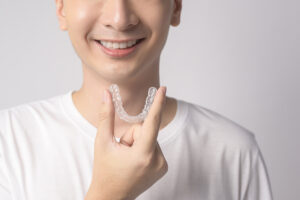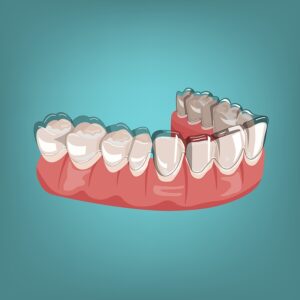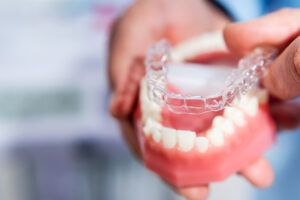Crossbites are a type of misalignment where one or more upper teeth bite on the inside of the lower teeth. This can happen on one side or both sides of the jaw. The condition can lead to serious oral health problems if left untreated. One of the popular solutions is using Invisalign.
Can Invisalign fix crossbite?
Many patients ask, “Can Invisalign fix crossbite?” Absolutely! Invisalign has been designed to treat a variety of dental issues, including crossbites. The clear aligners gradually move the teeth into the correct position over time. Invisalign offers custom-fitted trays that apply the right amount of pressure in the desired direction, helping in correcting crossbites effectively.
Types of Crossbites
Can Invisalign fix crossbite? Crossbites, while commonly referred to as a singular dental issue, can actually manifest in different ways. There are primarily two types of crossbites: anterior and posterior. Let’s delve into these types and see how Invisalign approaches each:
1. Anterior Crossbite (Underbite)
An anterior crossbite, commonly referred to as an underbite, occurs when the top front teeth sit behind the bottom front teeth when biting down. This is contrary to the typical alignment where the top front teeth should slightly overlap the bottom front teeth.
Invisalign’s Approach:
For anterior crossbites, Invisalign works by gradually moving the top teeth outward and/or the bottom teeth inward. The aligners exert gentle, controlled forces to rectify the misalignment. Depending on the severity, auxiliary treatments like elastics might be combined with Invisalign to achieve desired results.
2. Posterior Crossbite
A posterior crossbite occurs when one or more of the top back teeth bites down inside the bottom back teeth. This can happen on one side (unilateral) or both sides (bilateral) of the mouth.
Invisalign’s Approach:
For posterior crossbites, Invisalign aligners work by either expanding the upper arch, bringing the affected upper teeth outward, or a combination of both. The goal is to achieve a fit where the upper teeth sit outside of the lower teeth. Again, depending on the extent of the misalignment, adjunctive tools like expanders might be recommended alongside Invisalign.
How long does Invisalign take to fix a crossbite?
When asking, “Can Invisalign fix crossbite?” and how long it does, the duration of treatment largely depends on the severity of the crossbite and the individual’s specific needs. Generally, for mild to moderate crossbites, treatment can range from 12 to 24 months. However, for more complex cases, the duration might be extended. A consultation with an orthodontist will give you a personalized timeline for your treatment.
How Invisalign Works—Step-by-Step
Invisalign, a modern alternative to traditional braces, offers a discreet and flexible solution for teeth straightening. If you’re curious on “Can Invisalign fix crossbite?” and about how the entire process unfolds, here’s a step-by-step guide:
1. Initial Consultation
Your journey begins with an orthodontic consultation. Here, the orthodontist assesses the nature of your dental misalignment and determines if you’re a good candidate for Invisalign.
2. Customized Treatment Plan
Using advanced digital imaging technology, the orthodontist captures a 3D image of your teeth. This image assists in crafting a precise treatment plan, mapping out the teeth’s movement throughout the treatment phase.
3. Creation of Aligners
Once the treatment plan is set, custom-made clear aligners are produced to fit your teeth perfectly. These aligners are made from BPA-free plastic, ensuring they’re non-irritating and safe for prolonged use.
4. Wearing the Aligners
Patients are advised to wear these aligners for 20-22 hours a day, only removing them for eating, drinking, brushing, and flossing.
5. Progressive Treatment
Every one to two weeks, you’ll switch to a new set of aligners. Each set progressively moves your teeth towards their desired position.
6. Regular Check-ups
Typically, you’ll visit your orthodontist every 6-8 weeks. These check-ups ensure that the treatment is progressing as planned and allows for any necessary adjustments.
7. Completion and Retention
Once the treatment phase concludes, and your teeth have reached their desired position, you’ll likely need to wear retainers. Retainers ensure that the teeth maintain their new position, preventing any unwanted shifts.
Benefits of Using Invisalign over Traditional Braces
Choosing between Invisalign and traditional braces can be daunting. To help, here’s a rundown of the benefits Invisalign offers over its metal counterpart:
1. Aesthetics
Invisalign aligners are clear and nearly invisible, allowing for discreet treatment. This is especially beneficial for adults and teens who might be self-conscious about wearing visible orthodontic appliances.
2. Comfort
Invisalign trays are made of smooth plastic, which reduces the chance of irritation to the cheeks and gums often experienced with metal braces.
3. Flexibility
The removable nature of Invisalign aligners means you can take them out during meals, ensuring no dietary restrictions. Traditional braces often come with a list of foods to avoid, like hard or sticky items.
4. Improved Oral Hygiene
Since Invisalign aligners can be removed, brushing and flossing are easier and more effective compared to navigating around metal brackets and wires. This leads to better oral health throughout the treatment period.
Does Invisalign fix overbite and crossbite?
Can Invisalign fix crossbite? How about an overbite? The simple answer is yes, Invisalign is versatile and can address both overbites and crossbites. An overbite is when the upper teeth overlap the lower teeth excessively. Just like with crossbites, Invisalign offers a treatment plan with custom-made aligners to shift the teeth into their optimal positions. For a comprehensive list of dental problems that can be addressed, check out the Problems we treat page.
Is fixing crossbite worth it?
Absolutely. Addressing a crossbite is not just about aesthetics; it’s about maintaining good oral health. Left untreated, crossbites can lead to uneven wear of the teeth, gum disease, and even jaw problems. Correcting the alignment ensures better bite function, prevents excessive tooth wear, and promotes overall dental health.
Potential Challenges and Solutions with Invisalign
1. Initial Discomfort
New aligners might cause some discomfort during the initial days. However, this typically subsides after a short period, and over-the-counter pain relievers can be helpful in managing this sensation.
2. Misplacing Aligners
Given their removable nature, aligners can be easily misplaced or lost. It’s essential to always use the provided case for storage and be especially mindful during meals to prevent misplacement.
3. Speaking Difficulties
Some users experience a temporary lisp when they first start wearing their aligners. This slight speech alteration usually diminishes as one gets accustomed to the aligners.
4. Oral Hygiene Maintenance
Aligners can trap food particles and bacteria against the teeth. To maintain optimal oral health, brush and floss after every meal and ensure the aligners are cleaned regularly.
Choose Orthodontic Excellence in Puyallup and Bonney Lake!
At Orthodontic Excellence located in Puyallup and Bonney Lake, we stand proud as Diamond Plus Invisalign Providers, placing us in the top 1% globally. With over 400 Invisalign cases annually, even tackling the complex ones, our expertise is unmatched. Been told Invisalign isn’t for you? Get a free second opinion with us.
For newcomers, we roll out a warm welcome with a FREE consultation and a chance to begin with $0 down and 0% financing (subject to good credit via third-party lenders).
Why settle? Choose excellence with us. Schedule Your Free Consultation!



 Puyallup
Puyallup